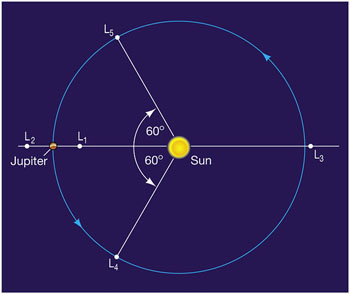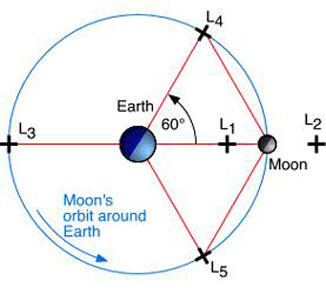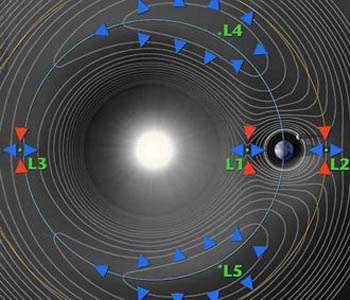|
Home,
home on...Lagrange?...
...The
Hidden Attractors In Your Chart
By
John Townley
Astrologers,
particularly modern ones, have a track record
of locking on to new, hidden, and often entirely imaginary planets to
explain
mysteriously active and apparently powerful yet unexplained points that
regularly seem to show up in horoscopes. If you spend much time in this
business, you run into degrees that seem to recur with great seeming
importance
in your own chart and those of others, whether clients or closer, and
there is
no reasonable astrological explanation for them. Everything else seems
to fit,
but
something still
remains that’s
begging for an explanation. The first inclination is to look to see if
there is
some unknown planet or midpoint, or harmonic, or something
that’s
maybe a little
off the map that you or perhaps everybody never noticed before.
Many an
astrologer has made a reputation off trying to fill that void, over the
years. That’s
how the Uranian planets came to be, hypothetical cyclical spots that
seemed to
explain power positions observed by German astrologers that
nothing
else could explain. Such points have flourished before and since,
including Vulcan, at least one
version of
Lilith, many different versions of “Planet X,” and
the
hopeful insertions of
the asteroids, later the Centaurs (Chiron the foremost), and now even
more
far-off bodies beyond Pluto, like Eris.
Indeed,
I spent decades
looking for something seemingly ever-present
at the totally vacant 7-8 Libra in my own chart that just
couldn’t be
explained. The closest I could come was that it might be my
most-aspected natal
degree (using major and much smaller minor aspects). Or, maybe it was
the
hypothetical planet Poseidon, and hey, I’m big into the
sea… The fact that it
was very simply the degree that provided the applying sextile to my
Moon
escaped me
because it seemed so mildly irrelevant – a soft aspect that
wasn’t such a deal
and whose effects by transit should be averaged out among many. It
should have
occurred to me that my other major mystery point was the degree of the
separating
sextile to my Sun at 23 Libra.
 
Lagrange points occur in
any orbit of one
body around another, mark stability and instability of position
Well,
maybe the more
inventive explanations like
newly-found or newly-fabricated bodies can explain all mysteries, but
simple
solutions are often the best. One of them includes two of the set of
five Lagrange
points,
which I have mentioned before here,
which may be one of the major clues to the basic Ptolemaic aspects and
the
overall structure of astrology. Gravitationally, there is a point of
attraction
– or, rather, orbital stability – just sixty
degrees (a
sextile) ahead of and
behind every body in orbit, that causes everything from planetary dust
to
full-blown planetoids to fall into and remain there. They are called
Lagrange
points 4 and 5, named after French mathematician Joseph
Louis Lagrange
who discovered them (or the principles behind
them).
Lagrange points 1 and 2 are points between and beyond two orbiting
bodies but exterior
to their orbits which achieve some sort of gravitational equilibrium,
often
used to hold satellites in stationary orbit, the equivalent
(astrologically) of
a conjunction. Lagrange point 3 is the orbital opposition point and
Lagrange
point 4 and 5 are sixty degrees (a sextile) on either side of a planet
along
the path of its orbit. And, of course, the aspect between Lagrange
points 4 and
5 themselves is 120 degrees, or a trine, the other basically stable
astrological aspect. Every other orbital aspect inherently possesses
varyingly greater
degrees of instability, most particularly including the square and the
opposition, while the conjunction pulls toward mutual equilibrium.
Sounds like
astrology to me.
There
is a lot still to
be looked at here before rushing
to judgment, especially including how you look at the orbits of the
planets
geocentrically (as if they were, literally, orbiting around the earth),
which
varies with retrogradation but has its own ultimate average (and which
is not
the same as reverting to a heliocentric view). Notwithstanding, it
won’t hurt
you to look at what’s sixty degrees before and after your
Lights,
for a start,
which may explain some of what you’ve been missing. Look
particularly to the
interior sextiles between your Lights (within their shortest mutual
arc), as
the same fundamental principles that govern near and far midpoints seem
to apply
here. That may tell you which is the more important orbital Lagrange
point (4
or 5) for each. Each one is a gravitational point of attraction and
rest which
resonates with the rest of your chart when any transiting or progressed
body
occupies it. In fact, what reveals itself is a network of attractor
points a
sextile ahead and behind each and all of your planets, where important
yet
unexplained transits will show up again and again. Things are
comfortable there
and ring the rest of your life like a well-tuned instrument.
 
U.S.A. chart (left) with
Lagrange points
for all planets. Points make shadow clusters of stability in otherwise
vacant areas. Right, the five L-points in space are shown with the L4
and L5 relative swaths of influence clustering near the sextile area.
It
doesn’t just
provide you with important points to look
at in your own chart. It’s very powerful in synastry and
composites. For
instance, when you get the classic ideal marriage comparison between
two charts
(Sun on Moon, or vice-versa), you’ll find the overlap of
mutual Lagrange
points, naturally swelling the resonance. An accident? Not at all. The
same
with synastry where one person’s planet is trine
another’s:
the Lagrange points
4 and 5 are the attractors that unite them fore and aft. When you apply
it to
composites, it becomes a resonance of the mutual midpoints themselves.
Worth a
thought. Check it out on the charts you know well and see if it
doesn’t reveal
an undisclosed locking mechanism, surprisingly physical and
all-encompassing.
It cannot be overemphasized that resonance and dissonance are the
fundamental
guiding principles of astrology. From the long period of the planetary
orbit
(in days or years) to the short alternation of the musical tone (cps or
Hz),
all are mutually related within their relative scaling and all seek out
the same
general set of proportions.
This
all may seem
theoretical,
but it would be nice if more of traditional astrology based on repeated
life observation could be linked with
its often
obvious fit within more simple and accepted astrophysical principles.
The more
you look, the more they seem to fit hand in glove. So, go try it out in
your
own chart, then others, and then go try and make friends with an
astronomer…LOL…!
Not
a
newsletter subscriber already? Subscribe
Free Here!
--
Breaking news from
around the globe, plus articles, reviews, it's all happening there,
changes daily...
|

